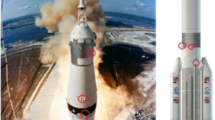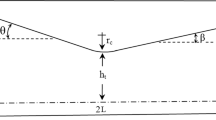Abstract
In this study, the nozzle flow influence on the forebody aerodynamics has been numerically investigated and validated with experiment. To understand the nozzle flow aerodynamics on the forebody, five different nozzle-exit profiles, which are often encountered in the experiments, are considered one at a time. One flow condition is considered at a nominal freestream Mach number of 4. The CFD simulations are performed using a two-dimensional axisymmetric four-equation transition shear stress transport (SST) turbulence model. The numerical results are compared with the Ludwieg tube Mach 4 experimental data and showed good agreement. The numerical results showed that despite the slight effect on the wall static pressure depending on the nozzle profiles considered, the physical flow phenomena such as shock shape are directly influenced. With the undeveloped nozzle flow profile case, however, significant pressure differences are observed. The distance between the model and the nozzle exit may significantly affect the forebody aerodynamic characteristics, and so, the consideration of the distance between the model and nozzle exit needs to be placed during the model setup to reduce the unwanted uncertainty in the measurement.















Similar content being viewed by others
References
Grossir G, Paris S, Bensassi K, Rambaud P (2013) Experimental characterization of hypersonic nozzle boundary layers and free-stream noise levels. In: 51st AIAA Aerosp Sci Meet Incl New Horizons Forum Aerosp Expo, AIAA Paper 2013-1130, Grapevine, Texas
Pate SR (1978) Dominance of radiated aerodynamic noise on boundary-layer transition in supersonic-hypersonic wind tunnels theory and application. In: NASA Technical Report, AEDC-TR-77-107
Pate SR (1980) Effects of wind tunnel disturbances on boundary-layer transition with emphasis on radiated noise: a review. In: 11th Aerodynamic Testing Conf, Colorado
Harvey WD (1978) Influence of free-stream disturbances on boundary-layer transition. In: NASA Technical Memorandum, NASA TM-78635
Sivells JC (1978) A computer program for the aerodynamic design of axisymmetric and planar nozzles for supersonic and hypersonic wind tunnels. In: NASA Technical Report, AEDC-TR-78-63
Sivells JC (1969) Aerodynamic design of axisymmetric hypersonic wind tunnel nozzles. In: 4th Aerodynamic Testing Conf, AIAA Paper 1969-337, Arnold Air Force Station, Tennessee
Shope F (2006) Contour design techniques for super/hypersonic wind tunnel nozzles. In: 24th AIAA Applied Aerodynamics Conference, AIAA Paper 2006-3665, San Francisco, California
Chan WYK, Jacobs PA, Smart MK, Grieve S, Craddock CS, Doherty LJ (2018) Aerodynamic design of nozzles with uniform outflow for hypervelocity ground-test facilities. J Propuls Power 34(6):1467–1478. https://doi.org/10.2514/1.B36938
Benton J, Perkins J, Edwards A (1990) Limitations of the method of characteristics when applied to axisymmetric hypersonic nozzle design. In: 28th Aerosp Sci Meeting, In: AIAA Paper 1990-192, Reno, Nevada
Candler G, Perkins J (1991) Effects of vibrational nonequilibrium on axisymmetric hypersonic nozzle design. In: 29th Aerosp Sci Meeting, AIAA Paper 1991-297, Reno, Nevada
Akinin SA, Goldfeld MA, Starov AV (2018) Flow parameters at the supersonic combustor entrance at tests in quasistationary impulse regime. In: Int Conf on the Methods of Aerophysical Research, Novosibirsk, Russia
Mi J, Nathan GJ, Nobes DS (2001) Mixing characteristics of axisymmetric free jets from a contoured nozzle, an orifice plate and a pipe. J Fluids Eng 123(4):878–883. https://doi.org/10.1115/1.1412460
Quinn WR (2006) Upstream nozzle shaping effects on near field flow in round turbulent free jets. Eur J Mech B/Fluids 25(3):279–301. https://doi.org/10.1016/j.euromechflu.2005.10.002
Yang SM (2019) Force and moment measurement of supersonic free-flight models in Konkuk University Ludwieg tube. Master Thesis, Konkuk University
Kim YJ, Byun YH, Park SH, Park G, Lee J (2018) Concept design of Ludwieg tube at Konkuk University. J Korean Soc Aeronaut Sp Sci 46(9):703–711. https://doi.org/10.5139/JKSAS.2018.46.9.703
Schrijer FFJ, Bannink WJ (2010) Description and flow assessment of the Delft hypersonic Ludwieg tube. J Spacecr Rockets 47(1):125–133. https://doi.org/10.2514/1.40773
Liepmann HW, Roshko A (2001) Elements of gasdynamics. Dover, New York
Oosthuizen PH, Carscallen WE (1997) Variable area flow. In: Compressible fluid flow. McGraw-Hill, International Ed, pp 174–224
Leonov S, Houpt A, Elliott S, Hedlund B (2018) Ethylene ignition and flameholding by electrical discharge in supersonic combustor. J Propuls Power 34(2):499–509. https://doi.org/10.2514/1.B36811
Tan J, Zhang D, Li H, Hou J (2018) Detailed experimental investigations on flow behaviors and velocity field properties of a supersonic mixing layer. Acta Astronaut 144:30–38. https://doi.org/10.1016/j.actaastro.2017.12.010
Mohanta PK, Sridhar BTN (2017) Study of decay characteristics of rectangular and elliptical supersonic jets. Therm Sci 21(6B):3001–3010. https://doi.org/10.2298/TSCI151224214M
Houpt A, Hedlund B, Leonov S, Ombrello T, Carter C (2017) Quasi-DC electrical discharge characterization in a supersonic flow. Exp Fluids 58(4):25. https://doi.org/10.1007/s00348-016-2295-5
Kim I, Lee S, Park G, Lee JK (2017) Overview of flow diagnosis in a shock tunnel. Int J Aeronaut Sp Sci 18(3):425–435. https://doi.org/10.5139/IJASS.2017.18.3.425
Wang Q, Li JW, Lu P, Li JP, Zhao W, Jiang ZL (2017) Pressure and heat flux calibration of the long-test-duration hypervelocity detonation-driven shock tunnel. In: 21st AIAA International Space Planes and Hypersonics Technologies Conference, AIAA Paper 2017-2155, Xiamen, China
Kim K, Park G, Jin S (2019) Flameholding characteristics of ethylene-fueled model scramjet in shock tunnel. Acta Astronaut 161:446–464. https://doi.org/10.1016/j.actaastro.2019.02.022
Lee S, Song H, Park G, Lee JK (2017) Freefalling heated sphere in a shock tunnel. AIAA J 55(11):3995–3998. https://doi.org/10.2514/1.J055967
Chang WK, Park G, Jin Y, Byun J (2016) Shock impinging effect on ethylene flameholding. J Propuls Power 32(5):1230–1239. https://doi.org/10.2514/1.B36007
Chang EWK, Yang S, Park G, Choi H (2018) Ethylene flame-holding in double ramp flows. Aerosp Sci Technol 80:413–423. https://doi.org/10.1016/j.ast.2018.07.012
ANSYS Inc (2013) Introduction to ANSYS Fluent. ANSYS Inc, Canonsburg, PA
ANSYS Inc (2013) Ansys Fluent user’s guide. ANSYS Inc, Canonsburg, PA
Oliden D (2013) Parametric analysis of a hypersonic inlet using computational fluid dynamics. Master Thesis, Arizona State University
Kadoya K, Matsunaga N, Nagashima A (1985) Viscosity and thermal conductivity of dry air in the gaseous phase. J Phys Chem Ref Data 14(4):947–970. https://doi.org/10.1063/1.555744
Rodriguez CG, Cutler AD (2005) Computational simulation of a supersonic-combustion benchmark experiment. In: 41st AIAA/ASME/SAE/ASEE Joint Propulsion Conference & Exhibit, AIAA Paper 2005-4424, Tucson, Arizona
Bigarella EDV, Azevedo JLF, Scalabrin LC (2007) Centered and upwind multigrid turbulent flow simulations of launch vehicle configurations. J Spacecr Rockets 44(1):52–65. https://doi.org/10.2514/1.23843
Carlson DR, Walters WP (1966) A supersonic/hypersonic aerodynamic investigation of the Saturn IB/Apollo upper stage. In: NASA Contract Report, NASA CR-362
Acknowledgements
This work was supported by the National Research Foundation of Korea (NRF) grant funded by the Korea government (MSIT) (No: NRF-2018M1A3A3A02065959). The authors appreciate Sung Min Lee, You Seok Lee, Eun Ju Kim, Hyeong Uk Kim, and Min Hyun Han at Konkuk University for their help in operating the Ludwieg tube.
Author information
Authors and Affiliations
Corresponding author
Additional information
Publisher's Note
Springer Nature remains neutral with regard to jurisdictional claims in published maps and institutional affiliations.
Rights and permissions
About this article
Cite this article
Park, S., Park, G. & Park, S.H. Nozzle Flow Influence on Forebody Aerodynamics. Int. J. Aeronaut. Space Sci. 21, 942–956 (2020). https://doi.org/10.1007/s42405-020-00274-7
Received:
Revised:
Accepted:
Published:
Issue Date:
DOI: https://doi.org/10.1007/s42405-020-00274-7




